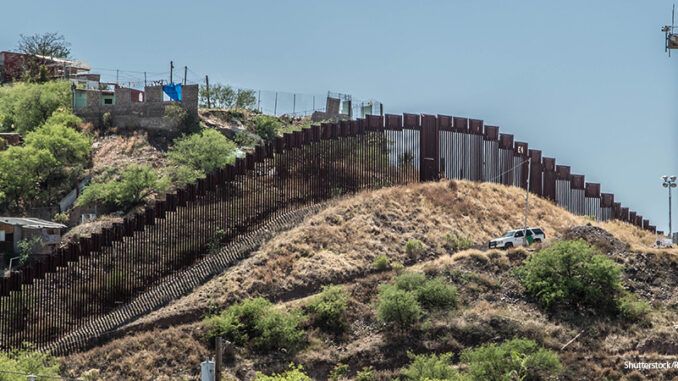
Building the Wall?
Few things about Trump’s presidency have been as hotly debated as the border wall he plans to build along the U.S. southern border. In fact, congressional disagreement over funding for the wall earlier this year led to the longest federal government shutdown in the nation’s history. More recently, Trump’s attempt to gain funding for the wall by declaring a national emergency on the southern border has been blocked by the nation’s court system. Now, one city has grown tired of all of the talk, debates, and delays, and has gone ahead and built their own section of the border wall.
In Sunland Park, New Mexico, a nonprofit organization called We Build The Wall raised $23 million in private donations since last December, enough to construct their own half-mile portion of the wall. The group says that this effort has been driven by the citizens who live in this town, who are concerned about theft and wish to increase border security. But not all residents of Sunland Park agree with this way of thinking. In fact, Mayor Javier Perea attempted to issue a cease-and-desist order last week because the project didn’t have the proper permits, but the city eventually allowed it to continue. The Sunland Park wall is now virtually complete.
The ultimate goal of the We Build The Wall organization is to raise $1 billion in private funds to begin building sections of the wall in other places along the border. The group hopes that their success in Sunland Park will cause a surge in donations from border security supporters around the country.
What Do You Think? Imagine that you live in Sunland Park. Write a letter to the mayor explaining why you do or don’t support having a section of the wall built in your city, and why. Please remember to be respectful in your letter.
The SAT’s New Scoring System
In March, btw brought you the story of a group of wealthy and celebrity parents who have been accused of cheating the college admissions system to get their children accepted into top universities. But this scandal, while troubling, brought to light many larger concerns about the fairness of the college admissions process as a whole. In general, wealthy students enjoy many advantages over poorer ones when applying to colleges: for example, they come from wealthier districts with more resources; they can afford expensive tutors and test prep courses; they can afford to take standardized tests several times to practice. As a result, only a very small percentage of students at top universities come from low-income backgrounds.

So what can be done to level the playing field? Recently, the College Board–the nonprofit group that administers the SAT–announced that it has developed an “Environmental Context Dashboard.” This is a new scoring system that will reflect the background a student comes from, such as the crime rate and poverty level in his or her neighborhood, family stability, and median family income. And no, this doesn’t give disadvantaged students an unfair “leg up”–rather, the College Board argues, it gives credit to students who are able to overcome challenging backgrounds, which in the end may be a greater measure of their future success than their ability to correctly answer a test question. Students are scored on a scale of 1 to 100, with 50 being average, and a score of higher than 50 indicating environmental hardship.
The program has already been piloted at 50 colleges and universities nationwide, with the hope to expand the program next year.
What Do You Think? What challenges have you overcome in your background? Do you feel that you should receive credit on your standardized tests for these hardships? Why or why not? Please remember to be sensitive of other students’ experiences with your answer.
Trash Wars?
Do you ever think about what happens to your trash once you throw it away? Where does it go? You might be surprised to find out that, while some of it winds up in landfills here in the United States, some of it is also shipped overseas. Years ago, Canada began sending nonrecyclable trash to the Philippines. But now, the Philippines have had enough, and are sending the trash back.
Here’s what happened: In 2013 and 2014, Canada sent more than 100 shipping containers of trash to the Philippines, claiming that the containers held recyclable materials. But turns out, they didn’t. In fact, they were actually full of household trash, including used adult diapers. Philippine President Rodrigo threatened to take back the Philippine ambassador and even declare war on Canada if they didn’t take back their trash. Duterte set a deadline for the trash to be removed, but Canada missed the deadline. Canada says that this is because it was trying to find an environmentally-responsible solution for the trash disposal. But regardless of the reason for the delay, last week, Duterte put 69 containers of the trash on a ship bound for Canada–at the cost of $1.14 million Canadian dollars. (26 of the remaining containers were buried in Philippine landfills.) What’s more: the Philippines are not the only Asian country plagued by this trash problem. In fact, both China and Malaysia have announced that they will also begin pushing back against other countries that are using them as a dumping ground for garbage.
In the case of the Philippines, Canada claims that the waste came from a private company, and the Canadian government is now looking at options to sue the company. But the larger question still remains: as long as the world keeps producing huge amounts of trash, where will it all go?
Dig Deeper In the past, how much of the world’s nonrecyclable trash has wound up in China?
Octo-Champs Win Spelling Bee
Though it may not be on your radar, the Scripps National Spelling Bee has happened every year for the past nine decades. And each year, one amazing student speller takes home a $50,000 cash prize. This year’s Bee, however, was very different. In fact, it ended in an eight-way tie. The Bee was a spelling marathon that lasted for three days, starting with a pool of 557 contestants ranging in age from 7 to 15. Twenty rounds later, sometime after midnight on the final day, the eight-way tie was declared.
The winners: Rishi Gandhasri (age 13, from California); Erin Howard (age 14, from Alabama); Saketh Sundar (age 13, from Maryland); Shruthika Padhy (age 13, from New Jersey); Sohum Sukhatankar (age 13, from Texas); Abhijay Kodali (age 12, from Texas); Christopher Serrao (age 13, from New Jersey); and Rohan Raja (age 13, from Texas). Some interesting facts about the winners: all three of the Texas champs are from the Dallas area, and Erin Howard is the first champion since 2007 without South Asian heritage. The eight winners spelled 47 consecutive words correctly.
Not everyone agreed with the decision to award an eight-way tie. Some former winners complained that this year’s words were simply too easy. There are also ongoing concerns about the role economic privilege plays in the Bee, as the majority of participants pay for private spelling coaches. However, the administrators stated that the Bee is supposed to be a test of spelling skill, not endurance, and say that by midnight, many of the young participants were exhausted and beginning to lose their voices. The winners themselves are pleased with the decision, calling themselves the “octo-champs.”
